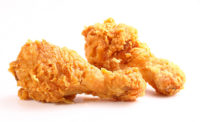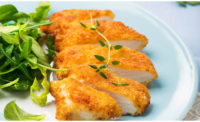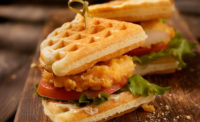Batters, breading go beyond bread crumbs

For the past decade, Chick-fil-A, for one, has quietly been phasing out trans fats, artificial food dyes, high-fructose corn syrup and some preservatives without alerting its consumers, unless they ask. Currently, Chick-fil-A is experimenting with a new peanut oil that doesn’t contain TBHQ, a chemical that extends the shelf life of oil but can be unhealthy in large doses, reported Business Week.
Despite whether consumers are aware of ingredient changes, they do view harder or rougher textured foods as having fewer calories, according to a recent study from University of South Florida.
“Consumers are driving the trend toward better-for-you coatings,” says Beau Guthrie, vice president of corporate accounts at HB Specialty Foods, in Nampa, Idaho, which works with the poultry and seafood industries. “In addition, we are seeing clean labels, organic, non-GMO ingredients driven by what manufacturers are hearing from customers.”
He notes ancient grains are now used in coatings, grains are being puffed (like they are with Rice Krispies) and cereals are crushed and blended in with bread crumbs to provide a unique texture and taste to replace missing fats.
“We are always getting requests for gluten-free flour — made from rice, corn or potato flour — not wheat flour, as well,” says Guthrie.
Due to revised school nutrition standards, breaded products are using more whole-grain coatings or lighter coating systems, he says.
“Portion control is key with healthier coatings too — how much coating is in each portion?” says Darrel Suderman, Ph.D., food industry technology and business consultant at Food Technical Consulting, in Denver. “All-natural, high-fiber coatings made with trans-fat-free oils and sprouted wheat flour, which has more protein, are also becoming more popular.”
No matter how healthy the new breadings and batters are, they also have to taste good.
“Our customers want unique flavor profiles, so they are using more spicy flavors like sriracha from Thailand, shakshuka sauce from Northern Africa and gochujang from Korea or regional, specific ones like Korean or Vietnamese,” says Guthrie.
Healthier coatings tend to be cooked in the oven as opposed to the fryer. So how do ingredient companies duplicate the crispy texture made by the fryer?
“By decreasing moisture in the batter, companies can create a crispier texture,” says Suderman. “Also, the breading material can bond with the clear coating system that is used on many french fries today.”
The same concept applies to coatings that must remain intact in microwave or oven containers that can reach up to 400 degrees. “These products also have increased adhesion starches that go a long way in driving eye appeal,” he says.
Another method is to sprinkle healthy oils, such as rice or soybean oils, on bread crumbs, so the coating achieves a nice golden brown color in the oven. “Crumbs can burn or become dry in the oven,” Guthrie says. “So oil also helps create a better mouth feel.”
In addition, manufacturers can use harder bread crumbs so they don’t become soggy from picking up too much moisture, he says.
To keep fried products healthier, processors are also experimenting with methods that will help coatings pick up less fat from the fryer.
“New oil additives seem to be showing progress but may not be commercialized yet,” says Guthrie.
Whether products are fresh or frozen, batters and breading enhance their flavor and texture.
“Flavor is ultimately the differentiating factor for consumers,” Suderman says. “The process begins with making sure the protein has a strong flavor, then the coating system encapsulates the flavor and lastly, the taste pops in consumers’ mouths.”
Looking for a reprint of this article?
From high-res PDFs to custom plaques, order your copy today!






